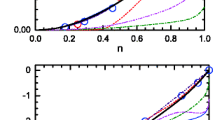Abstract
For an infinite Kitaev chain with an impurity described by a deltalike potential, we analytically prove that two overlapping Majorana bound states in a topologically trivial phase in the case of a small superconducting gap exist under the condition V0 = 2Δ, where V0 is the value of the potential and Δ is the superconducting order parameter. For a semi-infinite Kitaev chain with an impurity in the case of a small gap, we prove that there are two overlapping Majorana bound states in the trivial phase and one Majorana bound state in the topological phase and that the Majorana bound state in the latter case is stable under changes in the model parameters. We find explicit analytic expressions for the corresponding wave functions in all cases.
Similar content being viewed by others
References
S. R. Elliot and M. Franz, “Colloquium: Majorana fermions in nuclear, particle, and solid-state physics,” Rev. Modern Phys., 87, 137–163 (2015); arXiv:1403.4976v2 [cond-mat.supr-con] (2014).
J. Alicea, “New directions in the pursuit of Majorana fermions in solid state systems,” Rep. Prog. Phys., 75, 076501 (2012); arXiv:1202.1293v1 [cond-mat.supr-con] (2012).
M. Sato and S. Fujimoto, “Majorana fermions and topology in superconductors,” J. Phys. Soc. Japan, 85, 072001 (2016); arXiv:1601.02726v2 [cond-mat.supr-con] (2016).
S. Das Sarma, A. Nag, and J. D. Sau, “How to infer non-Abelian statistics and topological visibility from tunneling conductance properties of realistic Majorana nanowires,” Phys. Rev. B, 94, 035143 (2016).
A. Yu. Kitaev, “Unpaired Majorana fermions in quantum wires,” Phys. Usp., 44, 131–136 (2001); arXiv:condmat/ 0010440v2 (2000).
T. Karzig, G. Refael, and F. von Oppen, “Boosting Majorana zero modes,” Phys. Rev. X, 3, 041017 (2013).
S. Das Sarma, J. D. Sau, and T. D. Stanescu, “Splitting of the zero-bias conductance peak as smoking gun evidence for the existence of the Majorana mode in a superconductor-semiconductor nanowire,” Phys. Rev. B, 86, 220506 (2012).
Yu. P. Chuburin, “Existence of Majorana bound states near impurities in the case of a small superconducting gap,” Phys. E, 89, 130–133 (2017).
Yu. P. Chuburin, “Existence of Majorana bound states in a superconducting nanowire,” Theor. Math. Phys., 197, 1635–1644 (2018).
S.-J. Pablo, J. Cayao, E. Prada, and R. Aguado, “Majorana bound states from exceptional points in nontopological superconductors,” Sci. Rep., 6, 21427 (2016).
C. Moore, T. D. Stanescu, and S. Tewari, “Two-terminal charge tunneling: Disentangling Majorana zero modes from partially separated Andreev bound states in semiconductor-superconductor heterostructures,” Phys. Rev. B, 97, 165302 (2018); arXiv:1611.07058v1 [cond-mat.mes-hall] (2016).
C.-X. Liu, J. D. Sau, T. D. Stanescu, and S. Das Sarma, “Andreev bound states versus Majorana bound states in quantum dot-nanowire-superconductor hybrid structures: Trivial versus topological zero-bias conductance peaks,” Phys. Rev. B, 96, 075161 (2017); arXiv:1705.02035v2 [cond-mat.mes-hall] (2017).
A. Vuik, B. Nijholt, A. R. Akhmerov, and M. Wimmer, “Reproducing topological properties with quasi-Majorana states,” arXiv:1806.02801v2 [cond-mat.mes-hall] (2018).
M. A. Continentino, H. Caldas, D. Nozadze, and N. Trivedi, “Topological states in normal and superconducting p-wave chains,” Phys. Lett. A, 378, 3340–3347 (2014).
F. von Oppen, Ya. Peng, and F. Pientka, “Topological superconducting phases in one dimension,” in: Topological Aspects of Condensed Matter Physics (Lect. Notes Les Houches Summer School, Vol. 103, C. Chamon, M. O. Goerbig, R. Moessner, and L. F. Cugliandolo, eds.), Oxford Univ. Press, Oxford (2017), pp. 387–450.
Hosho Katsura, Dirk Schuricht, and Masahiro Takahashi, “Exact ground states and topological order in interacting Kitaev/Majorana chains,” Phys. Rev. B, 92, 115137 (2015).
Yu. P. Chuburin, “A discrete Schrödinger operator on a graph,” Theor. Math. Phys., 165, 1335–1347 (2010).
Author information
Authors and Affiliations
Corresponding authors
Additional information
This research was supported in part by the Ural Branch of the Russian Academy of Sciences (Grant No. 18-2-2-12).
Translated from Teoreticheskaya i Matematicheskaya Fizika, Vol. 200, No. 1, pp. 137–146, July, 2019.
Rights and permissions
About this article
Cite this article
Tinyukova, T.S., Chuburin, Y.P. Majorana States Near an Impurity in the Kitaev Infinite and Semi-Infinite Model. Theor Math Phys 200, 1043–1052 (2019). https://doi.org/10.1134/S0040577919070080
Received:
Revised:
Accepted:
Published:
Issue Date:
DOI: https://doi.org/10.1134/S0040577919070080




